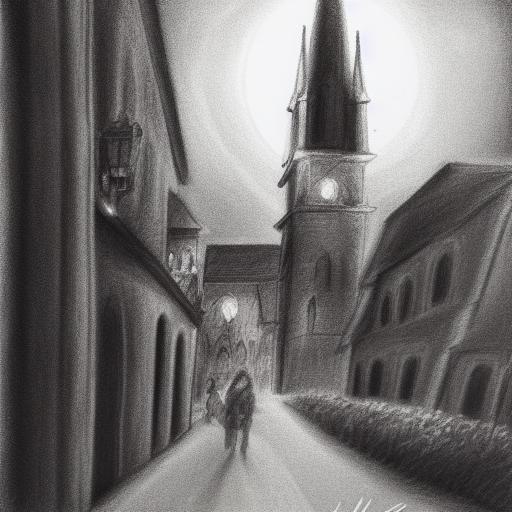How to write this prompt?
To write a prompt like the one given, you can start by identifying the key elements you want to include in the image. These can be specific objects, settings, colors, or styles. It’s also helpful to think about the mood or atmosphere you want to convey in the image. Once you have a list of elements, you can combine them into a cohesive prompt.
In the above prompt, the key elements include a black and white drawing, a city and church at night, a full moon, many flowers, a charcoal drawing by László Paál, a modern European ink painting, atmospheric lighting, and a city scene. Each of these elements influences the image being generated in different ways. For example:
- The black and white color scheme gives the image a classic and timeless feel, while also emphasizing the contrast between light and dark.
- The city and church setting at night suggests a sense of mystery and intrigue, while also providing an opportunity to play with interesting lighting effects.
- The full moon adds a touch of magic and whimsy to the image, while also serving as a focal point.
- The many flowers provide a contrast to the urban setting and add a sense of beauty and nature.
- The charcoal drawing by László Paál and modern European ink painting styles influence the overall aesthetic of the image, giving it a specific look and feel.
- The atmospheric lighting creates a sense of depth and dimension in the image, adding to the overall mood.
- The city scene ties all of the elements together and provides a context for the other elements to exist within.
By combining these elements into a prompt, the AI can generate an image that captures the essence of the prompt and creates a unique and visually striking image.
How to you prepare for a charcoal drawing?
Before starting a charcoal drawing, it’s important to have all the necessary materials on hand, including a set of charcoal sticks, an eraser, paper, and fixative spray. You’ll also want to choose a subject or reference image to draw from, and take the time to study the proportions and details of the subject. Some artists also prefer to do a rough sketch or underdrawing in pencil before beginning the charcoal work.
Who is László Paál?
László Paál was a Hungarian painter who lived from 1846 to 1879. He was known for his landscape paintings and charcoal drawings, which often depicted the natural beauty of the Hungarian countryside.
Is there any famous charcoal drawing out there?
Yes, there are many famous charcoal drawings throughout history. Some examples include Leonardo da Vinci’s “Vitruvian Man,” Michelangelo’s studies of male nudes, and Edgar Degas’ sketches of ballerinas.
Why do we use AI to generate photos?
We use AI to generate photos for a variety of reasons, including to automate repetitive or time-consuming tasks, to explore new artistic styles or techniques, and to generate images that would be difficult or impossible to create manually.
How does AI arts generation contribute to education world?
AI arts generation can contribute to the education world in several ways. Firstly, it provides new tools for students and educators to create and explore visual art. With AI-generated art, students can experiment with new styles and techniques that may not have been possible before, and educators can create custom teaching materials that are tailored to their students’ needs and interests.
Secondly, AI-generated art can be used to teach students about the creative process and the role of technology in art. By understanding how AI algorithms work and how they can be used to create art, students can develop a deeper appreciation for the intersection of art and technology.
Finally, AI-generated art can be used to create new learning experiences and educational resources. For example, AI-generated virtual reality environments could be used to teach history or science concepts in an immersive and interactive way, while AI-generated artworks could be used to teach art history or aesthetics.
Overall, AI art generation has the potential to revolutionize the way that art is taught and learned in the education world, offering new possibilities for creativity, exploration, and learning.
Designers can easily create visually appealing graphics by incorporating AI-generated art into their designs using tools like Visual Paradigm Online. With its user-friendly interface and a range of design templates and assets, Visual Paradigm Online enables users to experiment with different styles and layouts until they find the perfect combination. By seamlessly integrating AI-generated art into their designs, users can create stunning graphics in just a few clicks.


